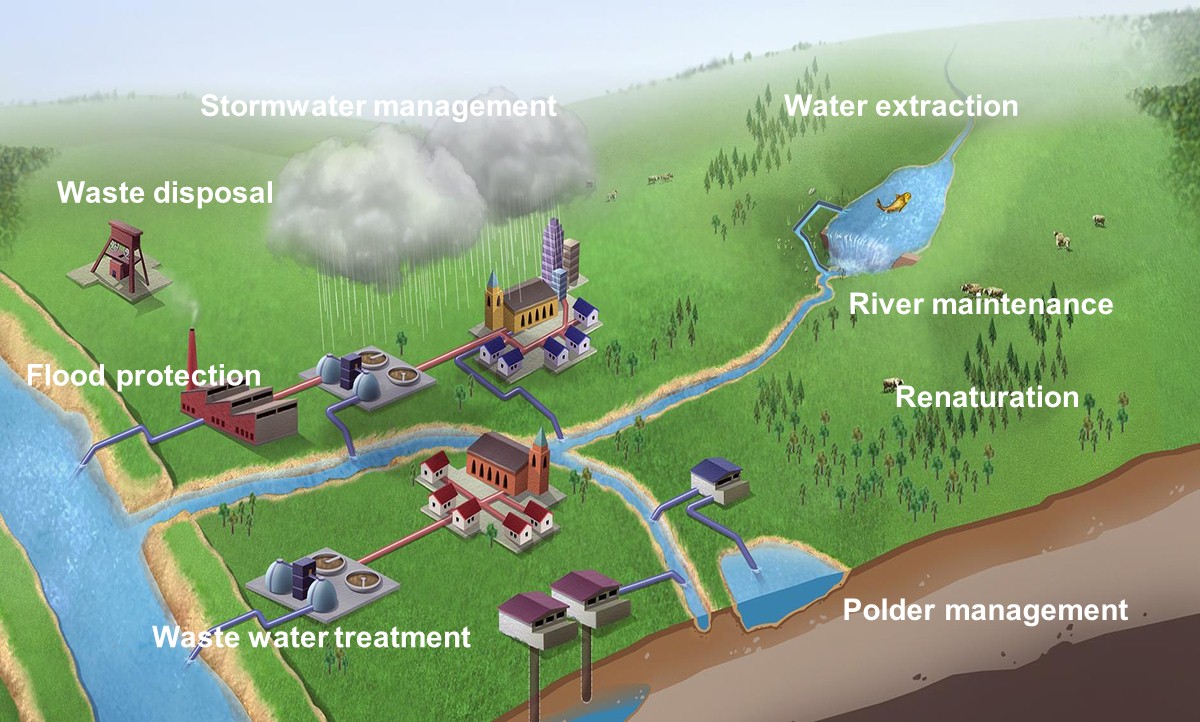A traditional solution in response to the expected water discharge needs would have be the construction of a sewer system that could cope with expected variation in water amounts. With the Emscher revitalization project a more transitional approach was taken strengthening the water cycle by converting the river and its tributaries into nature-like waterways and by having wastewater channelled through closed sewers. Gradually being developed, the valley already comprises cooling green spaces, areas for flood control, recreation areas and a habitat network. All these measures contribute to the enhancement of the quality of life in the Ruhr metropolitan area. Important key elements of the Emscher project were and are the natural restauration of the Emscher system, wastewater management with underground installations of the sewage system, consideration of flood protection in all projects and sustainable rainwater management with return of (clean) rainwater into natural water cycles. Further elements are educational initiatives around the Emscher Valley and the development of valuable recreation areas.
Nature-like water bodies have a higher capacity to buffer extreme weather events. In case of heavy rainfall, a nature-like water body has a higher retention capacity than a heavily modified one. The green belts accompanying the Emscher and its tributaries work as fresh air supply corridors for the dense urban areas. Wetlands and areas for stormwater retention cool down heat islands. The quality of life for people rises, heat stress is reduced, and new cycle paths along the water bodies provide possibilities for sustainable mobility. The overall approach taken is to integrate water management and urban planning for a water sensitive urban development.
Before projects such as dynaklim and Future Cities started, each actor in the Emscher region developed its own adaptation approach. For example, the water boards analysed whether their sustainable water management was fit to cope with expected impacts of climate change. Cities assessed their building stock and discussed which improvements would be needed in response to the heat island effect. Further, the Regional Association Ruhr (Regionalverband Ruhr) fostered its measurements of urban temperatures. With the support of these two projects a cross-sectoral approach was developed, including all relevant stakeholders from different sectors such as: water management, planning, building, health and emergency services. In addition, being a partner in the Future Cities project, the Emscher case served as an example to develop strategies to make urban regions fit to cope with the expected impacts of climate change. Within the project the joint tool “Future Cities Adaptation Compass” was developed to help urban regions to create their own adaptation strategy. This tool fostered very much an interdisciplinary approach to reach cross-sectoral solutions.
An example of an outcome of the Future Cities project is the sustainable development of two climate-proof industrial parks in Bottrop, in the Emscher region. Flash floods after heavy rainfalls often occurred on both sites. This situation is expected to be intensified with climate change. The Emschergenossenschaft and the Bottrop municipality agreed on a cooperation to restructure the industrial parks "Scharnhölzstraße" and "Boytal", thereby combining water, green and energy measures to make them climate-proof. The “Scharnhölzstraße” is an old business-site with an almost completely sealed surface. On the site, heavy rains tend to cause problems as well as overheating during periods of drought. A combined approach was taken for the public space on the one hand and the privately owned premises of the industry on the other hand. Decentralized solutions for rainwater (rainwater infiltration and rainwater use, solar power usage and green-zone enrichment) were envisaged to strengthen the area for upcoming climate events.
Although the Emscher system is now well prepared, torrential rainfall events can still cause flooding from time to time. Other conservation, requalification and adaptation projects have been therefore started or are planned. For example, in 2020 the Ruhr Conference initiated a new project called "Climate-resilient region with international charisma" (Klimaresiliente Region mit internationaler Strahlkraft). Within this project, the ecosystem-based and holistic approach applied in the Emscher region will be extended to the entire area of the Ruhr region. The Ruhr system covers an area of 4,435 km², in which approx. 5.1 million people live in 53 towns and communities. For the implementation of adaptation measures, funding with a volume of around 250 million euros will be available in this area over the next ten years.



